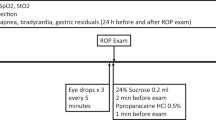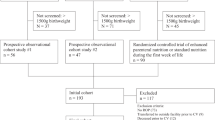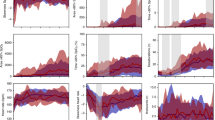Abstract
In this study, the relationship between the fluctuation in blood oxygen and carbon dioxide tension and the progression of acute retinopathy of prematurity (ROP) was evaluated. Eighteen extremely premature infants were selected on the basis of the following criteria: gestational age less than 26 weeks, oxygen supply or mechanical ventilation for more than 50 days, transcutaneous oxygen pressure (TcPO2) recorded almost once per hour, and arterial oxygen pressure (PaO2) and arterial carbon dioxide pressure (PaCO2) measured intermittently, for over 8 weeks after birth. All of these infants developed ROP, which ceased progressing in 7 infants (group 1, stage 1 or 2 ROP, international classification), but advanced in 11 (group 11, stage 3 or 3+). The fluctuations in TcPO2, PaO2, and PaCO2 are represented as coefficients of both variation (CV) and mean difference (D) in these two groups.
The results demonstrate that both the CV and D values of TcPO2 are significantly elevated in group II infants compared with group I infants, in the first and second 3-weeks periods, and over the entire 9-week period after birth. The incidences of extreme hyperoxemia (TcPO2 ≧ 100 mm Hg) and hypoxemia (TcPO2 < 30 mm Hg) in recorded TCPO2 time series show no significant differences between these two groups. We conclude that extremely premature infants with widely fluctuating arterial oxygen tension may have a greater chance of developing progressive ROP.
Similar content being viewed by others
References
Ashton N, Henkind P (1965) Experimental occlusion of retinal arterioles. Br J Ophthalmol 49:225–234
Ashton N, Ward B, Serpell G (1953) Role of oxygen in the genesis of retrolental fibroplasia, preliminary report. Br J Ophthalmol 37:513–520
Cho Y, Saito Y, Omoto T (1989) Retinopathy of prematurity and perinatal factors (Apgar score, fetal distress, intrauterine infection). Folia Ophthalmol Jpn (Ganki) 40:1933–1938
Committee for the Classification of Retinopathy of Prematurity (1984) An international classification of retinopathy of prematurity. Arch Ophthalmol 102:1130–1134
Flynn JT, Bancalari E, Bawol R et al. (1987) Retinopathy of prematurity. A randomized, prospective trial of transcutaneous oxygen monitoring. Ophthalmology 94:630–638
Gunn TR, Easdown J, Outerbridge EW, Aranda JV (1980) Risk factors in retrolental fibroplasia. Pediatrics 65:1096–1100
Hammer ME, Mullen PW, Ferguson JG, Pai S, Cosby C, Jackson KL (1986) Logistic analysis of risk factors in acute retinopathy of prematurity. Am J Ophthalmol 102:1–6
Horbar JD, Clark JT, Lucey JF (1980) The newborn oxygram, automated processing of transcutaneous oxygen data. Pediatrics 66:848–851
Johns KJ, Johns JA, Feman SS, Dodd DA (1991) ROP in infants with cyanotic congenital heart disease. Am J Dis Child 145:200–203
Katzman G, Satish M, Krishnan V (1987) Hypoxemia and retinopathy of prematurity. Pediatrics 80:972–972
Keith CG, Smith ST, Lansdell BJ (1981) Retrolental fibroplasia — a study of the incidence and aetiological factors, 1977–1979. Med J Aust 2:589–592
Kendall MG, Buckland WR (1981) A dictionary of statistical terms, 4th edn. Longman Group, London
Kinsey VE (1956) Retrolental fibroplasia, cooperative study of retrolentalfibroplasia and the use of oxygen. Arch Ophthalmol 56:481–543
Kinsey VE, Arnold HJ, Kalina RE et al. (1977) PaO2 levels and retrolental fibroplasia, a report of the cooperative study. Pediatrics 60:655–668
Lucey JF, Dangman B (1984) A re-examination of the role of oxygen in retrolental fibroplasia. Pediatrics 73:82–96
Majima A (1976) Problems on retinopathy of prematurity — statistical analysis of related to occurrence and progression of retinopathy, and fundus appearances and ocular functions in prematurely born subjects. Nippon Ganka Gakkai Zasshi 80:1372–1419
Nagata M, Terauchi T, Takeuchi A et al. (1988) Multicenter prospective studies of retinopathy of prematurity. I. Incidence and results of treatment. Nippon Ganka Gakkai Zasshi 92:646–657
Patz A, Hoeck LE, DeLaCruz E (1952) Studies on the effect of oxygen administration in retrolental fibroplasia. I. Nursing observations. Am J Ophthalmol 35:1248–1252
Perlman JM, Volpe JJ (1985) Episodes of apnea and bradycardia in the preterm newborn: impact on cerebral circulation. Pediatrics 76:333–338
Perlman JM, McMenamin J, Volpe JJ (1983) Fluctuating cerebral blood flow velocity in respiratory distress syndrome. N Engl J Med 309:204–209
Prendiville A, Schulenburg WE (1988) Clinical factors associated with retinopathy of prematurity. Arch Dis Child 63:522–527
Purohit DM, Ellison RC, Zierler S, Miettinen OS, Nadas AS (1985) Risk factors for retrolental fibroplasia: experience with 3025 premature infants. Pediatrics 76:339–344
Rooth G, Huch A, Huch R (1987) Transcutaneous oxygen monitors are reliable indicators of arterial oxygen tension (if used correctly). Pediatrics 79:283–286
Ruiz MPD, LeFever JA, Hakanson DO, Clark DA, Williams ML (1981) Early development of infants of birth weight less than 1000 grams with reference to mechanical ventilation in newborn period. Pediatrics 68:330–335
Saito Y, Uchihori Y, Omoto T (1984) The relation between the incidence of retinopathy of prematurity and systemic complications in very low birth weight infants. Folia Ophthalmol Jpn (Ganki) 35:2115–2119
Schulenberg WE, Prendiville A, Ohri R (1987) Natural history of retinopathy of prematurity. Br J Ophthalmol 71:837–843
Shahinian L, Malachowski N (1978) Retrolental fibroplasia — a new analysis of risk factors based on recent cases. Arch Ophthalmol 96:70–74
Shohat M, Reisner SH, Krikler R, Nissenkorn I, Yassur Y, Ben-Sira I (1983) Retinopathy of prematurity, incidence and risk factors. Pediatrics 72:159–163
Wolbarsht ML, George GS, Kylstra J, Landers III MB (1982) Does carbon dioxide play a role in retrolental fibroplasia? Pediatrics 70:500–501
Yu VYH, Hookham DM, Nave JRM (1982) Retrolental fibroplasia: Controlled study of 4 years' experience in a neonatal intensive care unit. Arch Dis Child 57:247–252
Author information
Authors and Affiliations
Rights and permissions
About this article
Cite this article
Saito, Y., Omoto, T., Cho, Y. et al. The progression of retinopathy of prematurity and fluctuation in blood gas tension. Graefe's Arch Clin Exp Ophthalmol 231, 151–156 (1993). https://doi.org/10.1007/BF00920938
Received:
Accepted:
Issue Date:
DOI: https://doi.org/10.1007/BF00920938




